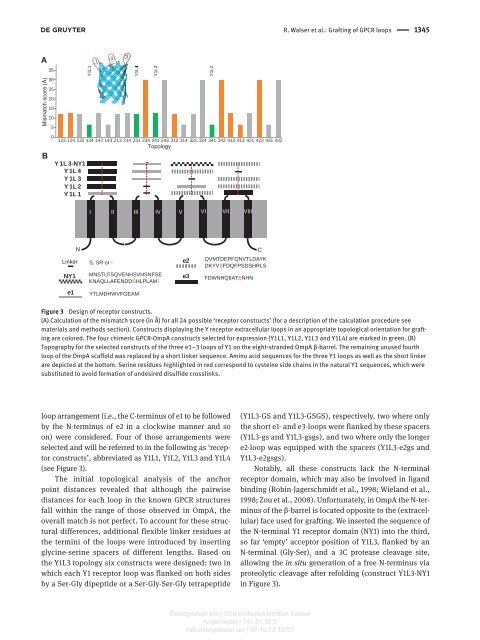β -Barrel scaffolds for the grafting of extracellular loops ... - KOBRA
β -Barrel scaffolds for the grafting of extracellular loops ... - KOBRA
β -Barrel scaffolds for the grafting of extracellular loops ... - KOBRA
You also want an ePaper? Increase the reach of your titles
YUMPU automatically turns print PDFs into web optimized ePapers that Google loves.
R. Walser et al.: Grafting <strong>of</strong> GPCR <strong>loops</strong> 1345<br />
A<br />
Mismatch score (Å)<br />
B<br />
Topology<br />
I<br />
II<br />
III<br />
IV<br />
V<br />
VI<br />
VII<br />
VIII<br />
N<br />
C<br />
Linker<br />
Figure 3 Design <strong>of</strong> receptor constructs.<br />
(A) Calculation <strong>of</strong> <strong>the</strong> mismatch score (in Å ) <strong>for</strong> all 24 possible ‘ receptor constructs ’ (<strong>for</strong> a description <strong>of</strong> <strong>the</strong> calculation procedure see<br />
materials and methods section). Constructs displaying <strong>the</strong> Y receptor <strong>extracellular</strong> <strong>loops</strong> in an appropriate topological orientation <strong>for</strong> <strong>grafting</strong><br />
are colored. The four chimeric GPCR-OmpA constructs selected <strong>for</strong> expression (Y1L1, Y1L2, Y1L3 and Y1L4) are marked in green. (B)<br />
Topography <strong>for</strong> <strong>the</strong> selected constructs <strong>of</strong> <strong>the</strong> three e1 – 3 <strong>loops</strong> <strong>of</strong> Y1 on <strong>the</strong> eight-stranded OmpA <strong>β</strong> -barrel. The remaining unused fourth<br />
loop <strong>of</strong> <strong>the</strong> OmpA scaffold was replaced by a short linker sequence. Amino acid sequences <strong>for</strong> <strong>the</strong> three Y1 <strong>loops</strong> as well as <strong>the</strong> short linker<br />
are depicted at <strong>the</strong> bottom. Serine residues highlighted in red correspond to cysteine side chains in <strong>the</strong> natural Y1 sequences, which were<br />
substituted to avoid <strong>for</strong>mation <strong>of</strong> undesired disulfide crosslinks.<br />
loop arrangement (i.e., <strong>the</strong> C-terminus <strong>of</strong> e1 to be followed<br />
by <strong>the</strong> N-terminus <strong>of</strong> e2 in a clockwise manner and so<br />
on) were considered. Four <strong>of</strong> those arrangements were<br />
selected and will be referred to in <strong>the</strong> following as ‘ receptor<br />
constructs ’ , abbreviated as Y1L1, Y1L2, Y1L3 and Y1L4<br />
(see Figure 3).<br />
The initial topological analysis <strong>of</strong> <strong>the</strong> anchor<br />
point distances revealed that although <strong>the</strong> pairwise<br />
distances <strong>for</strong> each loop in <strong>the</strong> known GPCR structures<br />
fall within <strong>the</strong> range <strong>of</strong> those observed in OmpA, <strong>the</strong><br />
overall match is not perfect. To account <strong>for</strong> <strong>the</strong>se structural<br />
differences, additional flexible linker residues at<br />
<strong>the</strong> termini <strong>of</strong> <strong>the</strong> <strong>loops</strong> were introduced by inserting<br />
glycine-serine spacers <strong>of</strong> different lengths. Based on<br />
<strong>the</strong> Y1L3 topology six constructs were designed: two in<br />
which each Y1 receptor loop was flanked on both sides<br />
by a Ser-Gly dipeptide or a Ser-Gly-Ser-Gly tetrapeptide<br />
(Y1L3-GS and Y1L3-GSGS), respectively, two where only<br />
<strong>the</strong> short e1- and e3-<strong>loops</strong> were flanked by <strong>the</strong>se spacers<br />
(Y1L3-gs and Y1L3-gsgs), and two where only <strong>the</strong> longer<br />
e2-loop was equipped with <strong>the</strong> spacers (Y1L3-e2gs and<br />
Y1L3-e2gsgs).<br />
Notably, all <strong>the</strong>se constructs lack <strong>the</strong> N-terminal<br />
receptor domain, which may also be involved in ligand<br />
binding (Robin -Jagerschmidt et al., 1998 ; Wieland et al. ,<br />
1998 ; Zou et al. , 2008 ). Un<strong>for</strong>tunately, in OmpA <strong>the</strong> N-terminus<br />
<strong>of</strong> <strong>the</strong> <strong>β</strong> -barrel is located opposite to <strong>the</strong> (<strong>extracellular</strong>)<br />
face used <strong>for</strong> <strong>grafting</strong>. We inserted <strong>the</strong> sequence <strong>of</strong><br />
<strong>the</strong> N-terminal Y1 receptor domain (NY1) into <strong>the</strong> third,<br />
so far ‘ empty ’ acceptor position <strong>of</strong> Y1L3, flanked by an<br />
N-terminal (Gly-Ser) 3<br />
and a 3C protease cleavage site,<br />
allowing <strong>the</strong> in situ generation <strong>of</strong> a free N-terminus via<br />
proteolytic cleavage after refolding (construct Y1L3-NY1<br />
in Figure 3).<br />
Bereitgestellt von | Universitaetsbiblio<strong>the</strong>k Kassel<br />
Angemeldet | 141.51.38.5<br />
Heruntergeladen am | 07.10.13 13:53















